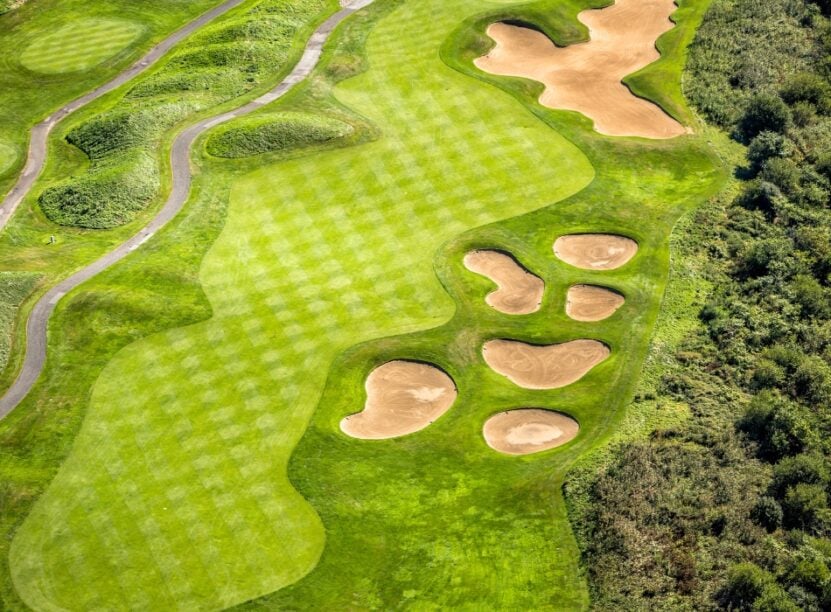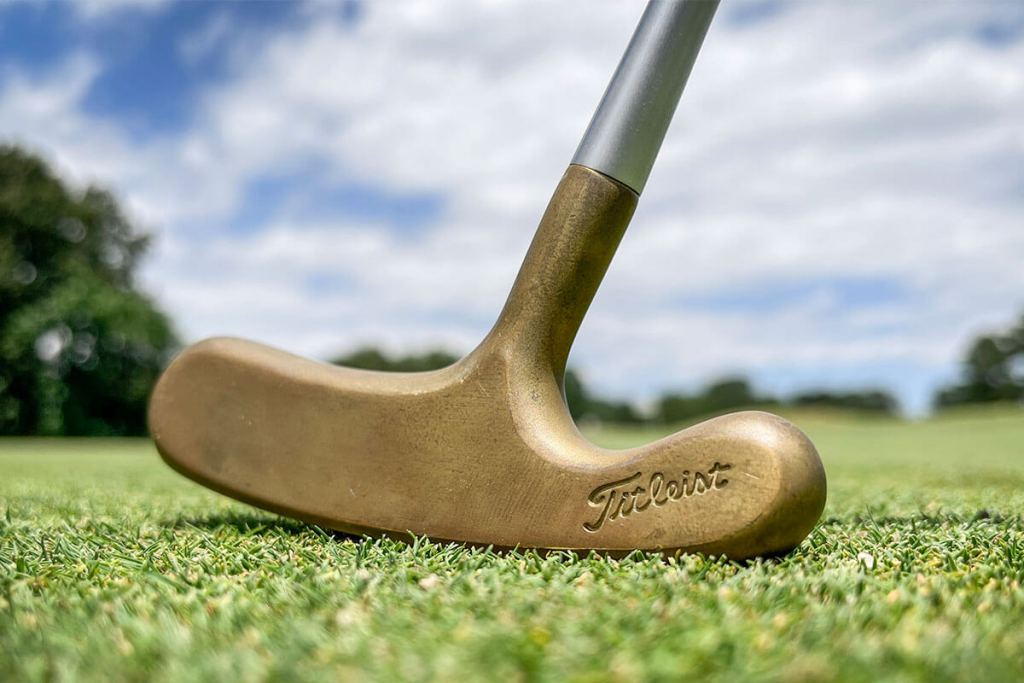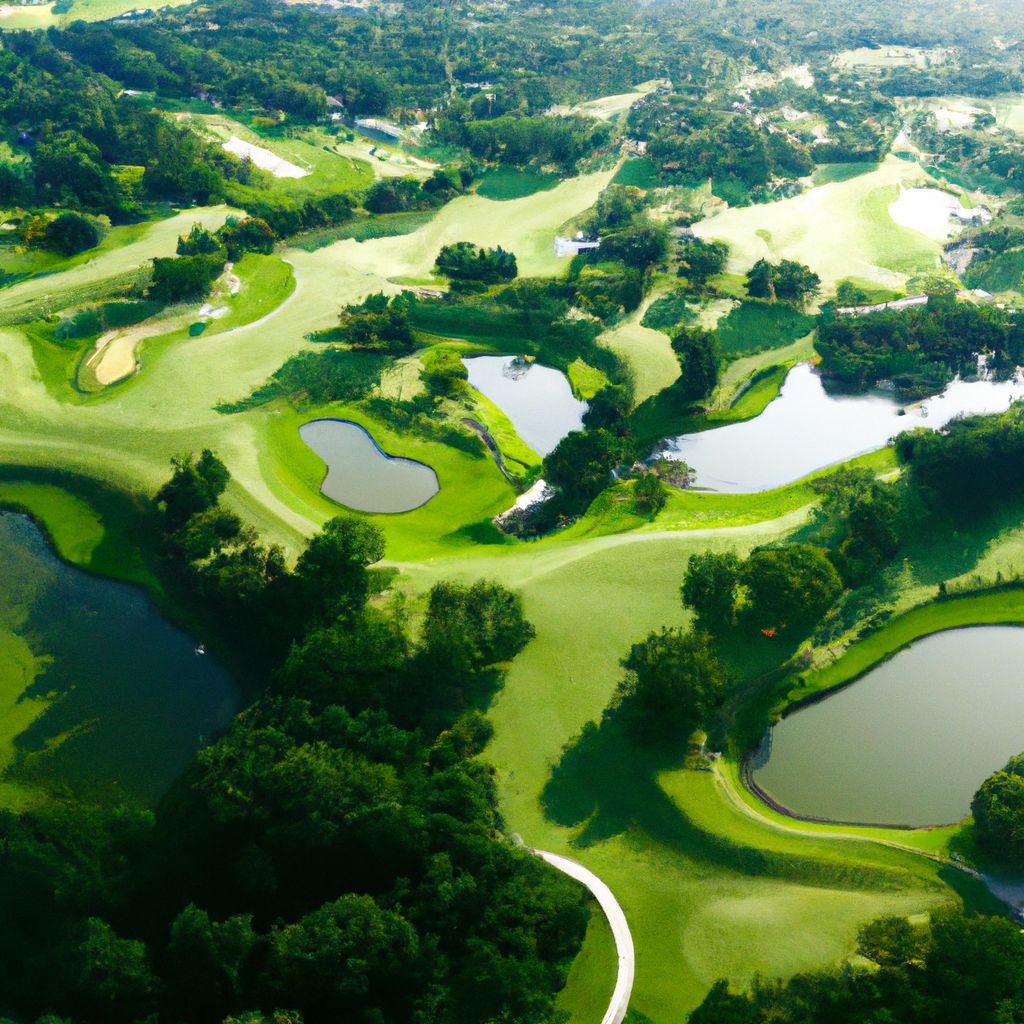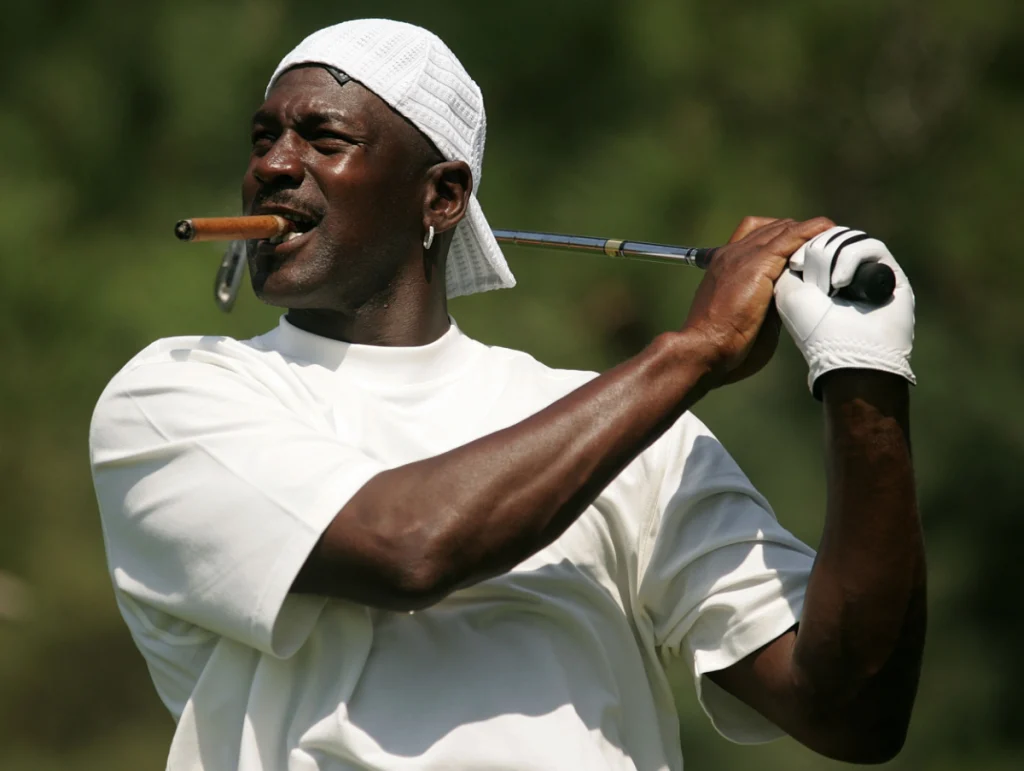Teeing Off Through Time: How did golf get its name?
“Golf” is a popular sport enjoyed by millions around the world, but have you ever wondered how it got its name? The origin of golf can be traced back centuries ago to ancient ball-and-club games played in various cultures. However, it was in Scotland that the game began to take its modern form and gain widespread popularity.
Early ball-and-club games, similar to golf, were played in ancient civilizations such as the Romans, Egyptians, and Chinese. These games involved hitting a ball with a club towards a target. Scotland, with its vast open spaces and undulating landscapes, provided the ideal setting for developing the game further.

The name “golf” itself has an interesting etymology. Several theories and speculations exist regarding its true origin. Some believe that the word “golf” comes from the Old Dutch word “kolf” or “kolve,” which referred to a club used in a hockey-like game. Others suggest that it may have originated from the Scottish word “goulf,” meaning “to strike or cuff.”
Throughout the years, golf evolved from a leisure activity to a globally recognized sport. It spread to other parts of the world, including England and the United States, and gained popularity among both amateur and professional players. The standardization of rules and equipment, such as the introduction of golf clubs with defined specifications and the establishment of official golfing bodies, further contributed to the development of the modern game.
Understanding the history and origins of golf, as well as the intriguing theories behind its name, adds an extra layer of fascination to the sport. So, the next time you tee off, remember the rich heritage this beloved game carries and the journey it has taken to become the golf we know today.
Key takeaway:
- Origin of Golf: Golf has its roots in early ball-and-club games and was developed in Scotland.
- The Name “Golf”: The word “golf” has an interesting etymology and various theories and speculations surround its origin.
- Evolution of the Modern Game: Golf spread across the world, witnessed standardization of rules and equipment, and has a debated and rich history.
Origin of Golf
Golf, a beloved sport played across the globe, has a fascinating origin rooted in history. In this section, we’ll explore the captivating stories and interesting facts behind the birth of golf. From the early ball-and-club games to the development of golf in Scotland, we’ll journey through time to discover the origins of this timeless sport. So, grab your clubs and join me on this fascinating exploration into the origins of golf.

Early Ball-and-Club Games
Early ball-and-club games, such as “club-and-ball” in ancient Egypt and “paganica” in ancient Rome, played a crucial role in the development of golf. These games, popular in medieval Europe and the Low Countries, were played on various terrains using different equipment. Despite regional variations in rules, the objective was always to hit the ball towards a target. These early ball-and-club games provided entertainment and exercise for players of all ages, laying the foundation for the development of golf in Scotland. By studying the history of these games, we can better understand the origins and evolution of golf as a sport.
The early ball-and-club games played throughout history set the stage for the modern game of golf. Through the centuries, the game has seen significant changes and enhancements. Understanding the roots of golf helps us appreciate the rich history and cultural significance of this beloved sport.
Before the invention of golf, the Scottish were just hitting rocks with sticks and calling it public transportation.
Development of Golf in Scotland
The development of golf in Scotland played a significant role in shaping the modern game of golf. Here are some key points to consider:
1. Origins: The origins of golf can be traced back to early ball-and-club games played in various forms across different cultures. However, it was in Scotland where the development of golf began to take shape as we know it today.
2. Early Scottish Golf: During the 15th century, the development of golf started gaining popularity in Scotland. The game was played on natural, coastal linksland that provided the ideal terrain for golf courses.
3. St. Andrews: The town of St. Andrews in Scotland emerged as a prominent center for the development of golf. The Royal and Ancient Golf Club of St. Andrews, founded in 1754, helped establish rules and regulations for the game.
4. Golf Courses: Scotland is home to some of the oldest and most renowned golf courses in the world. Courses like St. Andrews Links, Carnoustie, and Muirfield have been instrumental in the development and spread of the game.
5. Standardization of Rules: The development of standardized rules and equipment in Scotland helped create a consistent playing experience. This led to the growth of organized competitions and the establishment of golf as a sport enjoyed by people of all walks of life.
6. Impact on the Modern Game: The tradition and history of Scottish golf have had a lasting impact on the culture and development of the sport worldwide. Scotland’s influence can be seen in the design of golf courses, the terminology used, and the rules followed in modern golf.
7. Golf Tourism: The development of golf in Scotland has also contributed to the growth of golf tourism. People from around the world travel to Scotland to experience playing on historic courses and immerse themselves in the rich golfing heritage.
The development of golf in Scotland has shaped the sport into what it is today, with its rich history, iconic courses, and influential role in the standardization of rules. To truly understand and appreciate the game, exploring its Scottish roots is essential.
So, if you’re a golf enthusiast or simply interested in the history of this popular sport, consider delving into the fascinating development of golf in Scotland. It is a journey that will provide insights into the origins, traditions, and evolution of the game that is loved by millions worldwide.
After many heated debates and rounds of gossip, the origins of the word ‘golf’ remain as elusive as a hole-in-one.
The Name “Golf”
Discovering the origins of the word “golf” takes us on a fascinating journey into its etymology and the intriguing theories surrounding its origin. From ancient roots to modern speculations, we’ll delve into the rich history and diverse narratives that contribute to the mystery behind the name. Unraveling this linguistic enigma will shed light on the evolution of a sport and offer insights into the cultural significance that the name “golf” holds. So, let’s dive into the captivating realm of etymology and theories surrounding this beloved game.

Etymology of the Word “Golf”
The etymology of the word “golf” traces back to its origins in Scotland.
1. The word “golf” is derived from the Old Scots word “gouf” or “goff,” which dates back to the 14th century.
2. The exact origin of the word “gouf” or “goff” is uncertain, but it is believed to have come from either the Dutch or the Middle Dutch word “colf,” which means “club” or “stick.”
3. Another theory suggests that the word may have originated from the Old English word “golf” or “goulf,” which means “to strike” or “to cuff.”
4. The spelling of the word changed over time, and by the 16th century, it was commonly spelled as “golf.”
5. The word “golf” gradually became associated with the sport we know today, and it was first documented as referring to the game in 1457 in a Scottish Acts of Parliament.
6. The term “golf” eventually became the standardized name for the sport, and it has been used worldwide since then.
7. The popularity of the sport contributed to the widespread usage of the word “golf,” and it is now recognized and understood by people from various language backgrounds.
8. The etymology of the word “golf” reflects the historical development of the sport and its origins in Scotland, where it gained prominence and evolved into the modern game we know today.
Theories and Speculations
Theories and speculations surrounding the origin of the name “golf” have captivated historians and etymology enthusiasts for years. While the exact origin of the word remains a subject of debate, several theories have been proposed to shed light on its etymology.
One theory that is widely accepted posits that the word “golf” may have originated from the Old Dutch word “kolf” or “kolve,” which means “club.” This theory suggests that Dutch traders or sailors may have introduced the game of golf to Scotland, as they used to play similar ball-and-club games.
Another theory suggests that the word “golf” could have derived from the Middle High German word “golfe,” which means “to strike” or “to hit.” According to this theory, the name reflects the primary action of the game, which is striking the ball with a club.
Some speculations propose that “golf” might have evolved from the Scottish Gaelic word “goulf,” meaning “to shout” or “to yell.” According to this line of thought, the name could have originated from the boisterous shouts or calls made by players during the game.
There have also been speculations that the term “golf” could be an acronym for “Gentlemen Only, Ladies Forbidden,” implying that the game was originally exclusive to men. However, historians largely dismiss this theory as a playful and modern interpretation of the word.
While the specific origin of the name “golf” remains uncertain, these theories and speculations offer fascinating insights into the linguistic evolution of the word. It is important to acknowledge that the true etymology of “golf” may never be definitively determined, as language and cultural influences often intertwine in complex ways over time.
Golf: Where hitting a small ball into a tiny hole is considered a sport, and swearing like a sailor is just part of the game.
Evolution of the Modern Game
Golf, a beloved sport admired by millions, has a rich history that has shaped its evolution into the modern game we know today. In this section, we’ll explore the fascinating journey of golf as it spread its wings across the world and witnessed the standardization of rules and equipment. From its humble beginnings to a global phenomenon, we’ll uncover the transformative moments and key factors that have contributed to the game’s lasting popularity. So, grab your clubs and join us on this captivating exploration of the evolution of golf.

Spread of Golf Across the World
The spread of golf across the world has been a fascinating journey, with the sport gaining popularity in various countries and continents. Here are some key points to consider when exploring the spread of golf:
- Golf’s globalization: Golf has spread far beyond its origins in Scotland, where it was first developed. The sport has made its way to every continent, with courses and clubs established in North America, Europe, Asia, South America, and even Antarctica.
- Rapid growth: Over the years, golf has experienced significant growth in participation and interest worldwide. According to recent data, there are over 33,000 golf courses worldwide, catering to millions of golfers.
- Influence of professional tours: Professional golf tours, such as the PGA Tour and European Tour, have played a crucial role in popularizing the sport globally. These tours showcase top-level golfers from different countries, attracting fans and inspiring aspiring players.
- Rise of international tournaments: The establishment of international golf tournaments, such as the Masters, the British Open, and the US Open, has helped to promote the sport on a global scale. These prestigious events attract players and spectators from around the world.
- Golf’s impact on tourism: Golf has become a significant tourism attraction in many countries, with golf resorts and destinations drawing visitors who want to combine their love for the sport with a vacation experience. Countries like Scotland, Ireland, Spain, and the United States are known for their world-class golf tourism offerings.
- Emerging golf markets: While golf has a rich history in countries like the United Kingdom and the United States, there has been a surge in interest and investment in new golf markets. Nations such as China, South Korea, and the Middle Eastern countries have witnessed a boom in golf course construction and the emergence of talented golfers.
- Global golf associations: The presence of international golf associations, such as the Royal and Ancient Golf Club of St Andrews and the United States Golf Association, has helped to promote and regulate the sport worldwide. These organizations set standard rules and guidelines that are followed by golf courses and players globally.
The spread of golf across the world has undoubtedly contributed to its continued popularity and influence. As more countries embrace this beloved sport, it cultivates a sense of camaraderie, competition, and appreciation for its rich history and traditions.
For those interested in exploring golf’s global reach, consider visiting renowned golf destinations like St Andrews in Scotland, Pebble Beach in the United States, or the stunning courses in the Algarve region of Portugal. Participating in international tournaments or local golf events in different countries can also provide a unique perspective on the sport.
From a game played with rocks and sticks to a game played with expensive clubs and tiny balls, golf has come a long way. Just like the golfers who spend more time in the rough than in the fairway.
Standardization of Rules and Equipment
The standardization of rules and equipment played a crucial role in the evolution of the modern game of golf. It brought consistency and fairness to the sport, allowing players from different regions to compete on an even playing field. Let’s take a look at the key aspects of standardization in golf:
| Standardization of Rules | Standardization of Equipment |
| Golf’s rules were first standardized in 1744 with the creation of the Articles and Laws of the Edinburgh Golfers. These rules formed the foundation for the modern rules of golf. | In the early days of the sport, golf clubs and balls were handmade, leading to variations in their design and performance. However, with the growth of the game and the need for consistency, equipment standards were established. |
| As the game spread beyond Scotland, various golf clubs and societies introduced their own rules. This lack of uniformity posed challenges for players in different regions. To address this, the Royal and Ancient Golf Club of St Andrews and the United States Golf Association collaborated to develop a single set of rules that could be applied worldwide. | Golf equipment underwent standardization to ensure fairness and maintain the integrity of the game. Specifications were set for club length, weight, and design, as well as for golf balls and their compression. |
| The standardization of rules brought clarity and consistency to the game, making it easier for players to understand and follow the regulations. This created a level playing field for all participants, regardless of their geographical location. | By establishing equipment standards, golfers could trust that their clubs and balls met the requirements for fair play. This eliminated any advantage gained from using specialized or unique equipment, ensuring that success in the game relied on skill rather than gear. |
The standardization of rules and equipment in golf revolutionized the game, transforming it into the widely recognized and respected sport we know today. It allowed golfers to compete fairly, enabled the growth of professional tournaments, and enhanced the overall experience for players and fans alike.
To further enhance the game, ongoing efforts are made to update and refine the rules and equipment standards. These adjustments consider advancements in technology, evolving player techniques, and the need to accommodate a diverse range of golfers.
As golf continues to evolve, maintaining a balance between tradition and innovation is crucial. The standardization of rules and equipment ensures that the essence of the game remains intact while embracing progress and inclusivity.
Golf’s debated history is just as rich as its players’ bank accounts after a hole-in-one.
Debated History and Rich History of Golf
The debated history and rich history of golf date back centuries, with various theories about its origin and evolution. While the exact origins of golf remain a topic of debate, its history is undeniably rich and fascinating.

1. Origins: The origins of golf are believed to stretch back to ancient times. Some theories suggest it originated in ancient Rome, where a game called “paganica” was played using a bent stick and a ball made of feathers. Others believe it traces back to the 15th century in Scotland, where it gained popularity among the Scottish nobility.
2. Early Evolution: Golf underwent an evolution during its early years. The game was initially played on rough, natural landscapes, with players having to navigate various hazards and obstacles. The first recorded golf course, the Old Course at St Andrews, dates back to the 15th century and is still played on today. Golf began to spread across Scotland and eventually to other parts of the world.
3. Royal Connections: Golf’s rich history includes strong connections to royalty. King James II of Scotland was known for his passion for golf, banning it temporarily to ensure his soldiers focused on their archery skills. However, the ban was eventually lifted, and golf continued to thrive.
4. Modernization: Golf went through a process of modernization in the 18th and 19th centuries. The introduction of the gutta-percha ball and the development of mowing machines helped improve the quality of the game. Golf clubs were established, and the rules and etiquette of the game were formalized.
5. Global Spread: The 19th century saw the globalization of golf. The sport expanded beyond its Scottish roots and gained popularity in England and other European countries. Golf eventually made its way to America, with the first golf club, the Royal Montreal Golf Club, being established in Canada in 1873.
6. Professionalism: The early 20th century saw the rise of professional golf and the formation of the Professional Golfers’ Association (PGA). The establishment of major tournaments, such as The Open Championship and the U.S. Open, further elevated the status of the sport.
7. Modern Era: Today, golf is a global sport enjoyed by millions of people. The professional circuit features major tournaments, and players like Tiger Woods and Annika Sorenstam have become household names. Golf courses have evolved into stunning landscapes, with meticulously maintained fairways and greens.
Next time you pick up your clubs and head to the course, remember the centuries of debated history and rich history of golf, and enjoy the game that has stood the test of time.
Gentlemen Only, Ladies Forbidden
The phrase “Gentlemen Only, Ladies Forbidden” is commonly associated with the history of golf and refers to the exclusion of women from certain golf clubs and tournaments. During the early days of golf, it was a sport dominated by men, and many clubs had policies and practices that prohibited women from playing or becoming members. Here are some important points to consider regarding this historical aspect:
- Gender exclusion: Golf clubs that followed the “Gentlemen Only, Ladies Forbidden” principle enforced a strict gender divide, excluding women from participating in the sport. This discriminatory practice was prevalent in the 19th and early 20th centuries.
- Male-dominated sport: Golf was considered an activity for gentlemen, and the exclusion of women reflected societal norms of the time. It was believed that women’s participation would disrupt the “exclusive” nature of the sport.
- Impact on women: The exclusion of women from golf clubs limited their opportunities to develop their skills and compete at a high level. It also hindered their ability to network and advance their careers in the business world, as many business deals were made on the golf course.
- Slow progress towards inclusivity: Over time, societal changes and women’s advocacy have led to more inclusivity in the world of golf. Many golf clubs have lifted their restrictions and opened their doors to female members and players. Additionally, women’s golf tournaments and professional tours have gained recognition, providing opportunities for women to showcase their skills.
- Ongoing challenges: Despite progress, challenges remain in achieving full gender equality in golf. Women continue to face barriers in terms of representation, sponsorship opportunities, and prize money compared to their male counterparts.
Today, the phrase “Gentlemen Only, Ladies Forbidden” serves as a reminder of the exclusionary practices of the past and the ongoing efforts to make golf a more inclusive and diverse sport. It is important to recognize and address these historical inequities to ensure equal opportunities for all golfers, regardless of their gender.
The Modern Concept of Golf
Golf has evolved over time, and the modern concept of the sport encompasses various aspects that make it unique and enjoyable. In understanding the modern concept of golf, it is important to consider the following key elements:
1. Rules and Etiquette: The modern concept of golf is governed by a set of rules and etiquette that ensure fair play and sportsmanship. Golfers are expected to adhere to specific guidelines regarding equipment, behavior on the course, and respect for fellow players.
2. Golf Courses: The modern concept of golf includes beautifully designed and well-maintained golf courses. These courses can vary in size and layout, offering different challenges for players of all skill levels. From lush fairways to challenging roughs and strategically placed hazards, golf courses provide a unique and immersive experience.
3. Equipment: Golf clubs and other equipment have evolved to enhance the playing experience. Modern golf clubs are made with advanced materials and technology, allowing players to achieve greater distance, accuracy, and control. Golf balls have also undergone advancements, offering improved aerodynamics and performance.
4. Scoring: The modern concept of golf revolves around scoring, with the aim to complete a round of golf in as few strokes as possible. Each hole on the course has a predetermined par score, and players aim to exceed expectations by hitting the ball into the hole in fewer strokes.
5. Skill Development: Golf is a sport that requires a combination of physical skill and mental focus. The modern concept of golf involves cultivating and honing various skills, such as driving, iron play, chipping, and putting. Players constantly strive to improve their technique, consistency, and decision-making abilities.
6. Community and Social Aspect: Golf is not just a sport; it is also a social activity that fosters camaraderie and connection. Many golfers enjoy playing with friends, family, or business associates, taking part in club competitions or tournaments, and enjoying post-round gatherings.
By considering these elements, one can grasp the modern concept of golf and appreciate the sport’s multifaceted nature. The combination of rules, courses, equipment, scoring, skill development, and social aspects contribute to the unique experience that golf offers.
Fact: Golf is enjoyed by approximately 61 million people worldwide, with the United States having the highest number of golf courses globally, boasting over 15,000 courses.
The Evolution of Golf Equipment
The continuous development of golf equipment has played a significant role in shaping the game as we recognize it today. From the early days of wooden clubs to the contemporary and technologically advanced equipment, golfers have observed remarkable changes that have improved their performance on the course.
1. Club Materials: In the past, clubs were crafted from wood, commonly ash or hickory. Nonetheless, with the advancements in technology, club materials have advanced to incorporate steel, titanium, and carbon fiber. These materials offer increased durability, strength, and flexibility, ultimately resulting in improved club speed and distance.
2. Club Design: Throughout the years, club design has experienced noteworthy transformations. The innovation of the cavity back iron, for example, completely revolutionized club forgiveness by redistributing weight around the clubhead perimeter. This design enables a larger sweet spot, assisting golfers in achieving improved accuracy and consistency.
3. Shaft Technology: The evolution of golf equipment has also influenced shaft technology. Formerly, shafts were constructed with hickory, which provided limited flexibility and power transfer. Nowadays, golfers have the option to choose from various shaft materials, including graphite and steel, each offering distinct levels of stiffness and torque tailored to suit individual swing characteristics.
4. Ball Technology: The development of golf balls has witnessed tremendous advancements. Previously, golf balls were composed of solid rubber, but present-day golf balls are engineered with multiple layers and dimples to optimize aerodynamics and enhance spin control. These innovations have led to increased distance, better control, and improved overall performance.
5. Golf Club Fitting: Another significant aspect of the evolution of golf equipment is the focus on custom club fitting. With the availability of sophisticated fitting systems, golfers can now have their clubs customized to their specific swing characteristics, encompassing club length, lie angle, and grip size. Custom fitting ensures that golfers possess equipment optimized for their individual needs, resulting in improved performance on the course.
6. Golf Technology: The evolution of golf equipment has also integrated technology into the game. Golfers can now utilize devices such as launch monitors and GPS rangefinders to analyze their swings, track distances, and make informed decisions on the course. These technological advancements provide golfers with invaluable data and insights to enhance their gameplay.
Undoubtedly, the evolution of golf equipment has transformed the game, enabling golfers to achieve longer, straighter shots with greater precision and consistency. As technology continues to progress, it will be fascinating to witness the emergence of new innovations that push the boundaries of golf equipment even further.
Key Figures in Golf History
The history of golf is rich with influential individuals who have shaped the sport into what it is today. From legendary players to visionary architects, these key figures in golf history have left an indelible mark on the game.
| Name | Contribution |
| Old Tom Morris | Pioneered the concept of professional golfers and was a dominant player in the mid-19th century. |
| James Braid | One of the “Great Triumvirate,” along with Harry Vardon and J.H. Taylor, who dominated golf in the early 20th century. Braid won five Open Championships and was renowned for his course design skills. |
| Alister MacKenzie | A highly influential golf course architect responsible for designing some of the greatest courses in the world, including Augusta National, Cypress Point, and Royal Melbourne. |
| Bobby Jones | A golfing icon who achieved remarkable success in the 1920s. Jones won 13 major championships, including the Grand Slam in 1930. He also co-designed Augusta National and was instrumental in the establishment of the Masters Tournament. |
| Arnold Palmer | One of the most beloved and charismatic players in golf history. Palmer’s aggressive playing style and down-to-earth personality popularized golf and attracted a new generation of fans. He amassed 62 PGA Tour wins and won seven major championships. |
| Jack Nicklaus | Considered by many as the greatest golfer of all time, Nicklaus has a record 18 major championships. His rivalry with Arnold Palmer and his strategic approach to the game made him a legend. Nicklaus also designed numerous golf courses worldwide. |
| Tiger Woods | A transcendent figure in golf who dominated the sport in the late 1990s and early 2000s. Woods revolutionized the game with his athleticism, mental toughness, and remarkable shot-making ability. He has won 15 major championships to date and has inspired a new generation of golfers. |
These key figures in golf history have shaped the sport through their remarkable achievements and contributions. From Tom Morris and Bobby Jones to Jack Nicklaus and Tiger Woods, they have elevated golf to new heights and inspired generations of golfers worldwide.
For those interested in exploring the history of golf, learning about these influential individuals provides invaluable insight into the evolution of the game. Understanding their contributions can enhance your appreciation for the sport and provide a deeper connection to its traditions.
As we continue to witness new stars rising in golf, it is important to acknowledge and appreciate the key figures who laid the foundation for the modern game. Their passion, talent, and dedication have left an enduring legacy that continues to shape the sport we love today.
Some Well-Known Facts About How Golf Got Its Name:
- ✅ The word “golf” originates from the Dutch word “kolf” or “kolve,” which means “club.” (Source: Our Team)
- ✅ The term “golf” appeared in written language around 1425 and is believed to have its roots in the Dutch language. (Source: Our Team)
- ✅ The modern version of golf developed in Scotland and dates back to approximately 1552. (Source: Our Team)
- ✅ The origin of the word “golf” is debated, with theories suggesting it may come from Scottish words meaning “to strike or cuff.” (Source: Our Team)
- ✅ The word “golf” was not initially associated with any gender restrictions, and the myth of it representing “Gentlemen Only Ladies Forbidden” is false. (Source: Snopes)
Frequently Asked Questions
1. How did golf get its name?
The word “golf” originated from the Dutch word “kolf” or “kolve,” meaning “club,” and evolved into “goff” or “gouff” in the Scottish dialect before becoming “golf” in the 16th century.
2. Is it true that golf stands for “Gentlemen Only Ladies Forbidden”?
No, the origin of the word “golf” as “Gentlemen Only Ladies Forbidden” is false. This is a persistent myth and has no truth value.
3. What is the earliest documented mention of the word “golf”?
The first documented mention of the word “golf” is in Edinburgh in 1457 when King James II banned it to encourage archery practice.
4. How did the word “golf” spread from Scotland?
The linguistic connections between Dutch and Scottish words can be attributed to the trade industry between the Netherlands and the east coast of Scotland from the 14th to 17th centuries. It is believed that Dutch sailors brought the Dutch game of “kolf” to Scotland, which eventually evolved into the game of golf.
5. Were there other names for golf in older Scottish writings?
Before dictionaries, there was no standardized spelling. Various spellings of “golf” were used, such as goff, gowf, goif, goiff, gof, gowfe, gouff, and golve. The most common term for golf was believed to be “gowfe,” pronounced “gouf.”
6. What is the origin of the term “mulligan” in golf?
The origin of the term “mulligan” in golf is debated. One story suggests it was named after a golfer named David Mulligan who re-teed after a poor shot, while another story claims it was named after a locker room attendant named John A. “Buddy” Mulligan who replayed shots.



